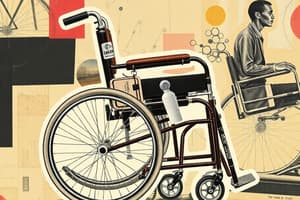Podcast
Questions and Answers
Which statistical measure is most appropriate for assessing the test-retest reliability of the slalom test results for wheelchair-using youth with spina bifida?
Which statistical measure is most appropriate for assessing the test-retest reliability of the slalom test results for wheelchair-using youth with spina bifida?
- Intraclass correlation coefficient (ICC) (correct)
- Paired t-test
- Pearson correlation coefficient
- Multiple regression
In the study, what served as the criterion measure for establishing the construct validity of the Muscle Power Sprint Test (MPST)?
In the study, what served as the criterion measure for establishing the construct validity of the Muscle Power Sprint Test (MPST)?
- One Stroke Push Test (1SPT)
- Arm-cranking Wingate Anaerobic Test (WAnT) (correct)
- Slalom test
- 10x5 Meter Sprint Test (10x5MST)
What primary criterion was used to assess the content validity of the Muscle Power Sprint Test (MPST) in the provided research?
What primary criterion was used to assess the content validity of the Muscle Power Sprint Test (MPST) in the provided research?
- Correlation with the WAnT results
- Expert opinion on test appropriateness
- Time-based criteria for anaerobic testing (correct)
- Comparison with the 10x5 Meter Sprint Test
If a new participant performs the 10x5 Meter Sprint Test (10x5MST) and scores significantly higher than the established norms for wheelchair-using youth with spina bifida (SB), what might this indicate?
If a new participant performs the 10x5 Meter Sprint Test (10x5MST) and scores significantly higher than the established norms for wheelchair-using youth with spina bifida (SB), what might this indicate?
In the context of this study, what does a high intraclass correlation coefficient (ICC) value for the slalom test indicate?
In the context of this study, what does a high intraclass correlation coefficient (ICC) value for the slalom test indicate?
What is the primary purpose of calculating the smallest detectable change (SDC) in the context of the skill-related fitness tests?
What is the primary purpose of calculating the smallest detectable change (SDC) in the context of the skill-related fitness tests?
How might the findings of this study regarding the validity and reliability of fitness tests be most directly applied in clinical practice?
How might the findings of this study regarding the validity and reliability of fitness tests be most directly applied in clinical practice?
Why is it important to establish both the validity and reliability of skill-related fitness tests for wheelchair-using youth with spina bifida?
Why is it important to establish both the validity and reliability of skill-related fitness tests for wheelchair-using youth with spina bifida?
Flashcards
Muscle Power Sprint Test (MPST)
Muscle Power Sprint Test (MPST)
A test to measure anaerobic power in wheelchair users, involving repeated sprints.
10x5 Meter Sprint Test (10x5MST)
10x5 Meter Sprint Test (10x5MST)
A sprint test performed over a 10-meter distance, repeated 5 times, to assess agility and speed.
Slalom Test
Slalom Test
An assessment involving navigation through a series of obstacles to evaluate maneuverability.
One Stroke Push Test (1SPT)
One Stroke Push Test (1SPT)
Assessment of upper body power, involving a single push stroke.
Signup and view all the flashcards
Construct Validity
Construct Validity
The degree to which a test measures what it is intended to measure
Signup and view all the flashcards
Content Validity
Content Validity
The degree to which the content of a test is representative of the domain it is supposed to cover.
Signup and view all the flashcards
Reliability
Reliability
The consistency and repeatability of a test's results.
Signup and view all the flashcards
Smallest Detectable Change (SDC)
Smallest Detectable Change (SDC)
Statistic that indicates the absolute magnitude of measurement error in the same units as the original measurement
Signup and view all the flashcardsStudy Notes
- The study assesses the Muscle Power Sprint Test (MPST), 10×5 Meter Sprint Test (10×5MST), slalom test, and One Stroke Push Test (1SPT) for youth with spina bifida (SB) using wheelchairs.
- The study is a clinimetric study design.
- The setting includes rehabilitation centers, SB outpatient services, and private practices.
- Participants included 53 children and adolescents (32 boys, 21 girls, ages 5-19) with SB using manual wheelchairs.
- Participants were from rehabilitation centers, SB outpatient services, therapists, and the BOSK.
- The study did not use interventions.
Main Outcome Measures
- Construct validity of the MPST was determined by comparing it to the arm-cranking Wingate Anaerobic Test (WAnT) using t tests and Pearson correlation coefficients.
- Content validity was assessed using time-based criteria for anaerobic testing.
- Construct validity of the 10×5MST, slalom test, and 1SPT was analyzed by hypothesis testing using Pearson correlation coefficients and multiple regression.
- Reliability was assessed using intraclass correlation coefficients (ICCs) and smallest detectable changes (SDCs).
- The mean exercise time for 4 MPST sprints was 28.1±6.6 seconds.
- Correlations between the MPST and arm-cranking WAnT were high (r>.72, P<.01).
- Excellent correlations were found between the 10×5MST and slalom test (r=.93, P<.01).
- Correlations between the 10×5MST or slalom test and MPST and 1SPT were moderate (r=-.56 to -.70; r=.56, P<.01).
- 38% of the 1SPT variation was explained by wheelchair mass (β=-.489) and total upper muscle strength (β=.420).
- All ICCs were excellent (ICCs>.95), but the SDCs varied widely.
- The MPST is a valid and reliable test for measuring anaerobic performance in youth with SB using wheelchairs.
- The 10×5MST and slalom test are valid and reliable for measuring agility.
- The 1SPT has questionable validity and reliability.
Background
- Assessing and enhancing physical fitness is important for youth with chronic conditions like spina bifida (SB).
- Approximately 50% of children with SB use a wheelchair.
- Skill-related fitness includes power, speed, agility, coordination, balance, and reaction time.
- Skill-related fitness impacts activities for youth using wheelchairs, such as play and sports.
Skill-Related Fitness Tests
- The MPST measures anaerobic performance combining power and speed.
- Content validity assesses if a measurement instrument adequately reflects the measured construct.
- Construct validity assesses if the scores of a measurement instrument align with hypotheses.
- The arm-cranking Wingate Anaerobic Test (WAnT) is a criterion standard for assessing anaerobic capacity.
- Agility is measured by the 10×5 Meter Sprint Test (10×5MST) and slalom test.
- The One Stroke Push Test (1SPT) measures aspects of coordination.
- Reliability focuses on the degree to which a measurement is free from error.
Methods
- The Medical Ethics Committee approved the study.
- Parents and children 12+ signed informed consent.
- The study is part of the "Let's Ride...study.”
- Participants were recruited in the Netherlands with specific inclusion criteria (SB diagnosis, wheelchair use).
- Age, sex, type of SB, lesion level, and wheelchair type were recorded.
- Arm span length was used to indicate height.
- Body mass index was adjusted for midlumbar/thoracic lesions.
Exercise Testing
- Standard instructions and demonstrations were provided with encouragement.
- A habituation period preceded each test with 5 minutes rest.
- The Muscle Power Sprint Test involved propelling a distance of 15m and repeated 6 times with 10 seconds.
- Power output was calculated.
- The arm-cranking WAnT involved using an arm ergometer with increasing speed to apply force and measure power.
- The 10×5 Meter Sprint Test involved sprinting and turning 10 times between 2 lines that were 5m apart.
- The Slalom test involved participants weaving between 4 cones.
- The One Stroke Push Test involved covering as much distance as possible with one push.
- Leg strength was measured by the CITEC dynamometer.
Statistical Analysis
- A sample size estimation was performed before data collection.
- Data were analyzed for normality using plots, histograms, & scatterplots.
- Content validity of the MPST was determined through sprints lasting close to 30 seconds.
- Construct validity was assessed via Pearson correlation coefficients & paired t-tests between MPST & WAnT.
- Pearson correlation coefficients were used for construct validity between MPST, 10×5MST, slalom test & 1SPT.
Results
- The study included 53 participants (32 boys, 21 girls), with a mean age of 13.6 years.
- The exercise time for 6 sprints was 42.5 seconds, leading to the calculations of MP and PP being based on 4 sprints.
- High correlations were found between the arm-cranking WAnT and the MPST for both PP and MP.
- Correlations were found between the 10+5 meters slalom & sprint test
- Correlations were also found from other sprint and muscle tests.
- Significant relations among variables like wheelchair mass and total upper muscle strength were observed
Reliability
- Reliability was analyzed using ICC Shrout and Fleiss model 2.1.A.
- The standard error of measurement agreement and the smallest detectable change (SDC) were determined.
- Correlations were defined with specific cutoffs (Moderate, High and Excellent) Content Validity
- Considering content validity, the mean exercise time for 6 sprints was 42.5 s
- 4 sprints were therefore calculated for MP and PP at 28.1 ± 6.6 s.
Discussion
- A total of 4 sprints were calculated based on sprint time for children,
- The differences might be explained by differences in performance in continuous or intermittent performance.
- The inexpensive MPST, is a good alternative for measuring anaerobic performance.
- The wheelchair is important in performance of skill-related fitness.
- Researchers recommend lightweight wheelchairs and upper muscle strength.
- Good ICCs are important in providing information about change to individual patients.
- Important to clarify minimal change and responsiveness of tests
Study limitations
- There were no objective criteria for max testing. Second, the time could have some error given manual recording. Third only Interrater reliability can be interpreted.
- For wheelchair-using youth should be adapted to 4 sprints, that said even will high reliability, large measurement errors affect its clinical usefulness.
- High construct/reliability mean usefulness for clinicians is questionable.
Studying That Suits You
Use AI to generate personalized quizzes and flashcards to suit your learning preferences.




